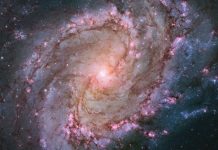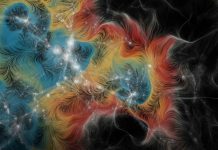
Astronomers have made a groundbreaking discovery by detecting carbon in a galaxy that existed just 350 million years after the Big Bang.
This is the earliest detection of any element other than hydrogen in the universe.
Using the powerful James Webb Space Telescope (JWST), an international team of astronomers led by the University of Cambridge observed a very young galaxy in the early universe and found it contained surprising amounts of carbon. Carbon is one of the essential building blocks of life as we know it.
In the field of astronomy, elements heavier than hydrogen or helium are referred to as metals. The early universe was almost entirely composed of hydrogen, the simplest element, with small amounts of helium and tiny traces of lithium.
All other elements that exist today were formed inside stars. When stars explode as supernovas, they spread these elements throughout their host galaxy, helping to form the next generation of stars.
With each new generation, more metals are created, eventually leading to the formation of rocky planets like Earth and, potentially, life.
Tracing the origins and evolution of these metals helps scientists understand how the universe transformed from being composed of just two elements to the complex array we see today.
“The very first stars are crucial to understanding chemical evolution,” said Dr. Francesco D’Eugenio, the lead author from the Kavli Institute for Cosmology at Cambridge.
“Since these stars were made only of the most basic elements, they behaved very differently from modern stars. By studying how and when the first metals formed in stars, we can understand the early steps that led to the creation of life.”
Carbon plays a vital role in the universe’s evolution because it can form dust grains that clump together, eventually forming the first planetesimals and planets. Carbon is also essential for the development of life on Earth.
“Previous research suggested that large quantities of carbon began forming about a billion years after the Big Bang,” said Professor Roberto Maiolino, a co-author also from the Kavli Institute. “But our findings show that carbon formed much earlier—it might even be the oldest metal of all.”
The team used the JWST to observe one of the most distant galaxies yet, just 350 million years after the Big Bang, over 13 billion years ago. This galaxy is small and compact, about 100,000 times less massive than the Milky Way.
“It’s like an embryo of a galaxy, but it could grow into something much bigger, like the Milky Way,” said D’Eugenio. “For such a young galaxy, it’s fairly massive.”
Using Webb’s Near Infrared Spectrograph (NIRSpec), the researchers broke down the light from the young galaxy into a spectrum of colors. Each element leaves a unique fingerprint in the spectrum, allowing the team to identify the galaxy’s chemical makeup.
They confidently detected carbon and found tentative signs of oxygen and neon, although further observations are needed to confirm these elements.
“We were surprised to see carbon so early in the universe,” said Maiolino. “We thought the earliest stars produced much more oxygen than carbon. The fact that we see carbon so early suggests that the first stars might have behaved differently than we thought.”
According to some theories, when the earliest stars exploded as supernovas, they released less energy than expected.
This allowed carbon, which was in the stars’ outer layers, to escape more easily and spread throughout the galaxy, while oxygen might have fallen back and formed black holes.
“These findings show that carbon could be enriched quickly in the early universe,” said D’Eugenio. “And because carbon is fundamental to life, it’s possible that life emerged much earlier in the universe than we thought. If life exists elsewhere, it might have evolved very differently from life on Earth.”
These exciting results have been accepted for publication in the journal Astronomy & Astrophysics and are based on data from the JWST Advanced Deep Extragalactic Survey (JADES). The paper is currently available on the arXiv preprint server.
Source: University of Cambridge.



